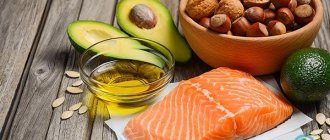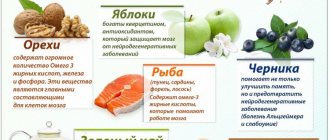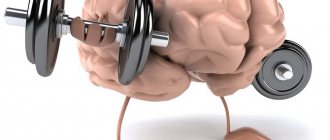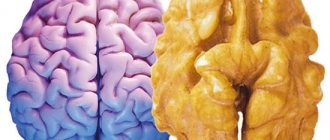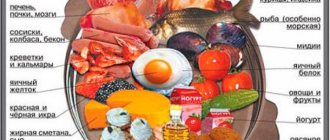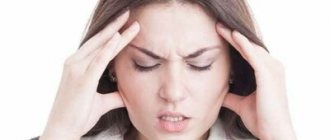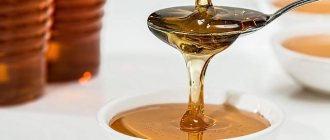Among the huge number of neurological diseases, the most common is migraine. Today, this pathology is a serious problem for all of humanity: about 10% of people on the globe suffer from it, and this figure is growing from year to year. Unfortunately, it is completely impossible to cure it. As with asthma or allergies, you can only relieve and control symptoms and minimize attacks. This is achieved by taking medications, as well as following a certain diet. What foods trigger migraines? How to make a diet correctly?
You need to know this
One of the main causes of
migraines is metabolic disorders
.
Indicative in this regard is an imbalance of serotonin and histamine, which regulate the functioning of the nervous and immune systems. In people suffering from the disease, there is very little serotonin, which constricts blood vessels, but there is quite a lot of histamine, which, on the contrary, dilates them. And this imbalance leads to serious headaches, loss of visual fields and other symptoms. Contrary to popular belief, migraine is not only a disease of women, although, indeed, it occurs more often among the fair sex. Symptoms can first appear at any age, but are more common in teenagers. The risk factor is heredity.
Tormented by a migraine? Review your diet
The development of migraine attacks can be provoked by certain foods, or so-called trigger foods.
What should you eat with caution?
Migraine is a severe headache that may be accompanied by blurred vision, nausea and vomiting. The first attacks usually begin at age 30 and are more common in women. Sometimes migraine runs in families. Attacks can be triggered by stress, as well as certain foods.
Migraine trigger foods include: sausages and sausages; herring, caviar and smoked fish; pork meat, game, offal (liver, kidneys, goiter, brains); salted and pickled foods and vinegar; some types of cheese (cheddar, Brie, etc.); products containing yeast (especially fresh bread); chocolate (milk and bitter); sugar and products containing it; caffeine (black tea, coffee); Coca-Cola and energy drinks; citrus fruits (when consumed in large quantities); cream, yoghurt, sour cream; legume products; flavor enhancers (monosodium glutamate); alcohol, especially red wine.
How to understand which foods trigger migraines for you?
Start keeping a food diary. Try to exclude from your diet that product from the list that you cannot live without for a day. According to medical observations, headaches are often caused by addiction to even one trigger product. For example, if a coffee lover gives up his favorite drink for at least a few weeks, the frequency of attacks decreases.
Why do some foods trigger migraines?
According to scientists, it's all about the chemicals they contain. Migraine attacks are especially often triggered by 5 substances.
- Nitrites
They are widely used in the meat processing industry. Contained in ham, salted meat, smoked fish, salami, sausages, bacon and other similar products. In humans, these substances can cause vasodilation and also provoke a dull throbbing pain in the temples.
- Amines
Biogenic (synthesized in the body) amines regulate mood, blood pressure, heart rate, and human sleep. They are released in response to stress and can trigger a chain of reactions leading to headaches. Some foods, such as red wine, liver, cheese, smoked fish, sour cream, yoghurt and yeast, contain tyramine - an amine that, when entering the human body , may have a similar effect.
- Monosodium glutamate
Monosodium glutamate is one of the most popular flavor enhancers, which is included in many spices. It is a neurotransmitter and can cause excessive stimulation of areas of the brain, which in turn leads to migraine attacks.
- Chocolate
One of the most powerful migraine triggers. Firstly, it provokes hypoglycemia due to its sugar and cocoa bean content. Secondly, chocolate contains caffeine, another strong migraine trigger. And thirdly, it contains finylethylamine, which, being an amine, causes vasoconstriction and, as a result, headaches.
- Sodium chloride
The reasons why table salt (sodium chloride) causes headaches are not completely clear to scientists. This may have something to do with increased blood pressure. If you want to follow a salt-free diet, it is not enough to stop adding salt when preparing food - you need to eliminate almost all industrially produced finished products.
Useful foods for migraines
The diet of a person who suffers from migraines should include: brown rice, buckwheat, oatmeal; dried fruits; oils (olive, corn oil, sunflower oil); sea fish; fresh anchovies; flax seeds; green vegetables (cucumbers, broccoli); pears, green apples, peaches, cherries.
The following also have a beneficial effect on the body: raisins, sweet cottage cheese; cream cheese, feta cheese; boiled eggs; low-fat milk; beets, celery; vegetable stew; tomato juice, sour fruit drinks and loose leaf tea.
In addition to a healthy diet, giving up bad habits, playing sports, walking and avoiding stress will help you overcome migraines.
At the same time, doctors warn that self-medication can be dangerous. Therefore, if you experience a headache or other symptoms of the disease, it is better to first consult a specialist.
Victoria YAKIMOVA
Photos from open Internet sources
Migraine and food
The concentration of serotonin and histamine depends on many factors, including nutrition. Some foods contain tyramine, nitrate additives, MSG, and more. Some of them relax blood vessels, others constrict. This triggers the mechanism for the development of pain. Based on this, when drawing up a treatment plan, doctors do not limit themselves to just taking medications, but also prescribe a specific diet. By eliminating migraine-causing foods from your diet, you can reduce the number of attacks and even the severity of pain. By strictly following all the doctor’s recommendations, it is possible to completely get rid of the disease.
Products for migraines
To control symptoms and prevent attacks, you should include the following foods in your diet:
- carbonated drinks, but without caffeine;
- raw chicken and quail eggs, or poached eggs;
- different types of meat and fish, which should be cooked exclusively by steaming. At the same time, it is advisable to eat it immediately after cooking, which will help you receive all the necessary nutrients
; - dairy products, including processed cheeses, but the milk should have a low fat content - no more than 2%;
- You should diversify your diet with cereals, from which you can make porridge;
- flour products, including pasta;
- vegetables and fruits that should be served fresh, boiled or steamed; • spices that will help give dishes a new taste;
- homemade broths and soups;
- natural and freshly squeezed juices;
- honey and other sweets;
- foods that contain large amounts of magnesium.
Nutrition rules
Nutrition is a factor that can help get rid of numerous diseases. This is also a factor that can lead to complications, the development of severe symptoms and exacerbation of diseases. Doctors recommend including natural foods in the diet, and the consumption of harmful ones should be limited and minimized. Following these simple rules will help relieve painful symptoms. There is another “side” effect - strengthening the immune system. It has long been known that errors in nutrition are provoking mechanisms. Hunger or large gaps between meals are provocateurs of severe headaches and other symptoms. Therefore, people suffering from symptoms are advised not to skip meals and always have access to snacks.
It is important to observe the drinking regime. You need to drink water regularly throughout the day, following general recommendations - at least 1.5-2 liters, depending on the time of year.
Trigger foods for migraines
In addition to healthy foods that need to be included in the diet, there are also those that should definitely be excluded or at least minimize their consumption. The list
of products that need to be limited includes the following:
- fermented milk products: fatty cheeses, sour cream. It is necessary to limit the amount of yoghurt and kefir;
- products made from yeast dough;
- some fruits: bananas, citrus fruits, dates and avocados;
- ice cream.
But there are also those foods that need to be completely excluded from the diet.
The fact is that during an attack they only increase the severity of pain, and outside of attacks they can provoke their appearance. First of all, you need to limit the consumption of drinks with a high content of caffeine and alcohol, even if we are talking about low-alcohol drinks. Sausages and semi-finished products cannot be called healthy, and they are completely contraindicated for people suffering from such serious headaches. Canned food, marinades and pickles should not appear on the table. Dishes and foods high in food additives, soy and walnuts can also cause headaches. You should not overuse fried and baked meat products. An active lifestyle, giving up bad habits, playing sports, walking, preventing stress are measures that will help prevent attacks.
Drug therapy and following a diet are measures that can reduce the severity of pain, reduce the likelihood of attacks, and, possibly, give a chance to forget about what a migraine is.
Text: Yulia Lapushkina.
Nutrition for migraines
Nowadays there is a lot of controversy among experts about the need for a diet for people suffering from migraine attacks. Many doctors and patients believe that certain foods (chocolate, red wine, cheese) can become a provoking factor in the occurrence of an attack. Recent experimental data are not so clear on this matter. Doctors give the following recommendations for building a diet for migraines.
- Avoid sugar fluctuations - eat small and often.
Why can a craving for a carbohydrate-rich food be a precursor to an attack? Researchers attribute this impulse to increased energy consumption in the brain in people with migraines. According to modern knowledge, the nervous system of patients processes information very quickly. The decisive factor is not so much the amount that a person eats, but the frequency and regularity of eating. Consistent blood sugar levels without significant fluctuations throughout the day can significantly prevent migraine attacks or reduce their incidence. To quickly raise your sugar levels, regular balanced meals with complex carbohydrates from whole grains, potatoes, fruits and vegetables are better instead of chocolate.
Don't skip meals, don't leave home without breakfast! If you remember this and take it into account, the risk of frequent attacks is already significantly reduced. Crash diets and low carbohydrate diets should be avoided. If the brain receives too few nutrients, or mainly fats and proteins, the risk of insufficient energy supply increases again. Brain cells burn only carbohydrates; they cannot normally obtain energy from fat or protein.
- Be careful with products that are provocateurs.
Recently, attitudes towards foods considered to trigger migraine attacks have changed. But the “expectation effect” remains for many patients. It is better for impressionable patients to refuse products that were considered dangerous for patients. These foods contain tyramine and tryptophan, which constrict blood vessels and increase blood pressure. There is a lot of tyramine in chocolate, cheeses (Parmesan, brie), nuts, and legumes. Tryptophan is present in avocados and milk. But you need to understand that such foods must be eaten in very large quantities for their effect to appear.
- Avoid dyes and preservatives.
Nitrates, glutamates, and aspartame are harmful to all people. They have a detrimental effect on the human body. Therefore, you should avoid canned foods, smoked foods, and marinades.
- Eliminate allergenic foods.
Serious allergic reactions can be triggered by histamine. Its active formation is promoted by products such as alcohol (especially red wine and beer), cheese, smoked meats, citrus fruits, and oranges. The list of allergens is much more diverse, as it is individual. If a person is prone to allergies, he should know his trigger foods. How can you identify similar products? You need to start with limited consumption of those types that do not cause an attack. Then one new product per week is gradually added. The results are recorded in a special headache diary. After identifying food triggers for migraines, foods that cause attacks are excluded from the diet. Doctors believe that eliminating allergens in 50% of cases reduces the frequency and severity of attacks.
- Drink coffee to avoid an attack.
Discussions about coffee never stop. Recently, he was finally rehabilitated. Moreover, if you drink it at the beginning of an attack, you can, if not prevent, then soften the headache. The main thing is that patients with hypertension should not get carried away with it and drink in large quantities.
- Eat healthy foods.
The diet should contain sufficient quantities of sea fish, vegetables, berries, fruits, and vegetable oil. Fermented milk products, high-quality cottage cheese, and rabbit meat are welcome. The beneficial effects of ginger, which prevents the development of an attack, have been proven. It is recommended to consume it both fresh and dry, drink its decoction as tea, and add it to salads.
- Introduce foods containing magnesium and B vitamins into your diet.
The diet should contain foods rich in vitamins and beneficial microelements. I would especially like to highlight products containing magnesium. B vitamins help reduce histamine levels; jacket potatoes, buckwheat, yeast, and asparagus are rich in them. Pumpkin, dates (in small quantities, as they are very high in calories), and celery, which contain folic acid, are useful.
- Pay attention to cooking.
Avoid fried foods! Stew, boil and bake foods. Nutritionists consider steaming food to be the ideal option. Strong broths, meat and chicken soups should not be in the diet. It is better to cook first courses in a mild vegetable broth.
- Drink enough fluids.
There is currently heated debate about the amount of water you should drink during the day. There are more and more arguments for common sense and the ability to listen to your body. Fluid intake must be adequate to the condition, since a large volume of fluid poses a serious burden on the heart and kidneys. You can’t limit yourself, but you shouldn’t go too far and force yourself to drink, trying to drink 3 liters of water a day.
Conclusion
So, the role of diet in getting rid of headaches is not that important. But errors in nutrition can “push” the body to an attack. Doctors warn that you need to:
- eat small and often meals;
- avoid strict diets, mono-diets and, especially, fasting;
- avoid overeating;
- adhere to a healthy diet;
- exclude allergenic products.
If you follow these recommendations, you can reduce the intensity of pain and the frequency of migraine attacks.
Migraine
This is a disease that manifests itself as intense paroxysmal, often unilateral, headaches of a pulsating and pressing nature and is localized in the forehead, temple, and around the eye. The attack is usually accompanied by nausea, increased sensitivity to daylight and sounds, and the pain is aggravated by normal physical activity.
The mechanism of a migraine headache attack. Pathogenesis of migraine.
Patients with such pain need a quiet, dark room so as not to worsen the headache. The attack lasts on average from 4 to 72 hours (without medication).
Considering the high development of medicine as a science, scientists do not fully know the causes of migraines, but there are theories that try to explain the occurrence of attacks. It is assumed that genetic, vascular and neurogenic factors play a significant role in this. The main mechanism is activation of the trigeminal nerve and excessive dilation of the blood vessels of the brain and its membranes (the so-called trigemenovascular theory).
It is worth noting that most often this disease affects young girls with symptoms appearing between the ages of 10 and 20 years and after 55-60 years, in most cases they stop.
Migraine provocateurs
Migraine is triggered by a variety of factors: - foods: alcohol, aged cheese, nuts, chocolate, citrus fruits; — violation of the daily routine (lack or excess of sleep); - stressful situations: hunger, physical fatigue, monotonous work; - other: weather changes, smoking, bright lights, loud noises, odors, neck pain, menstruation and PMS
Clinical picture
Let's highlight the key symptoms of a migraine attack:
- throbbing and pressing headaches mainly in one half of the head.
- medium to high intensity
- pain is localized in the forehead, temple, around the eye
- usually accompanied by nausea, vomiting at a height of pain, increased sensitivity to daylight and sounds.
- Pain may be aggravated by normal physical activity
— The duration of the attack is on average from 4 to 72 hours (without medication)
Also, a migraine attack may be accompanied by: pain in the neck, face, autonomic reactions, and neurological disorders.
Migraine with aura. What is an aura?
An aura is a temporary neurological symptom complex that occurs on average 1 hour before an attack of migraine pain. It can manifest itself in completely different ways:
- spots, flashes, spots before the eyes, fog, loss of field of vision;
- sounds, melodies; tingling, numbness, hypersensitivity;
- movement disorders.
- changes in the sense of taste and smell;
- also dizziness, stupor, problems with speech and concentration.
Diagnosis of migraine:
Migraine is a primary headache (that is, there is no specific cause for it) and is a disease of exclusion (that is, the doctor must be sure that there are no other causes of the headache). Often similar symptoms can result from: epilepsy, intracranial aneurysms, strokes, intracranial hemorrhages, infections of the central nervous system, tumors or vasculitis. The listed diseases are quite serious and often a clinical examination by a doctor and a conversation with the patient can exclude them. If necessary, additional studies are carried out, most often magnetic resonance imaging (MRI) and various blood tests.
Migraine treatment in St. Petersburg:
Treatment includes medications and non-drug methods. To relieve an attack, non-steroidal anti-inflammatory drugs (painkillers, such as ibuprofen or aspirin) and special anti-migraine drugs (triptans) can be used. At Smart Clinic we pay great attention to the prevention of migraine attacks. We help our patients: - optimize work and rest modes depending on the routine of each individual patient - identify attack provocateurs (triggers) and avoid them - to assess dynamics we use headache diaries and international rating scales - if necessary, we prescribe additional therapy or diagnostics.
As for direct treatment, in addition to classical therapy with tablet drugs, we can offer our patients acupuncture, massage and manual therapy, psychotherapy (since migraine often goes hand in hand with anxiety and depressive disorders).
Our doctors treat the patient as a whole, not specific symptoms, so each type of treatment is tailored individually during the appointment. We have accumulated extensive experience in the treatment of headaches, which means we can definitely help you cope with migraines.
Product restrictions
Although there are “official” contraindicated and recommended products, everything is individual. After the diagnosis of migraine is established, the patient should determine his own list of headaches that cause him pain.
To do this, it is important to completely exclude foods from the list of contraindications from the diet for two weeks. Then enter one item into the menu and monitor your condition. If headaches return after consuming any of them, then it is strictly contraindicated.
If a relapse does not occur, the product can be left in the diet. Typically, hazardous foods cause headaches within 3-6 hours of consumption.
It's also worth knowing that the list of individual dietary triggers may change several times throughout your life. But women with migraines should be especially attentive to their diet. Due to hormonal reasons, their personal triggers often vary even within 1 month.
For women during any hormonal changes (menstrual period, pregnancy, lactation, menopause), it is important to carefully monitor their diet and limit as much as possible the consumption of foods that provoke headache attacks.
People with migraines should not skip meals, snack on dry food, or even go hungry. Hunger and malnutrition are common factors that cause severe headaches. During attacks, doctors advise giving up salty, fatty, pickled foods, sweets, and red wine.
It is also necessary to limit the consumption of starchy foods (semolina, pasta, white bread), which cause the release of insulin, which in turn also provokes a migraine attack. During attacks, you should not conduct food experiments or introduce new or exotic foods into your diet.
And one more rule. People suffering from migraines should not eat ice cream or drink very cold drinks in hot weather, as the brain reacts painfully to temperature changes.
Every fifth case of ignoring this rule ends in a 2-day migraine (most often with a visual aura).
